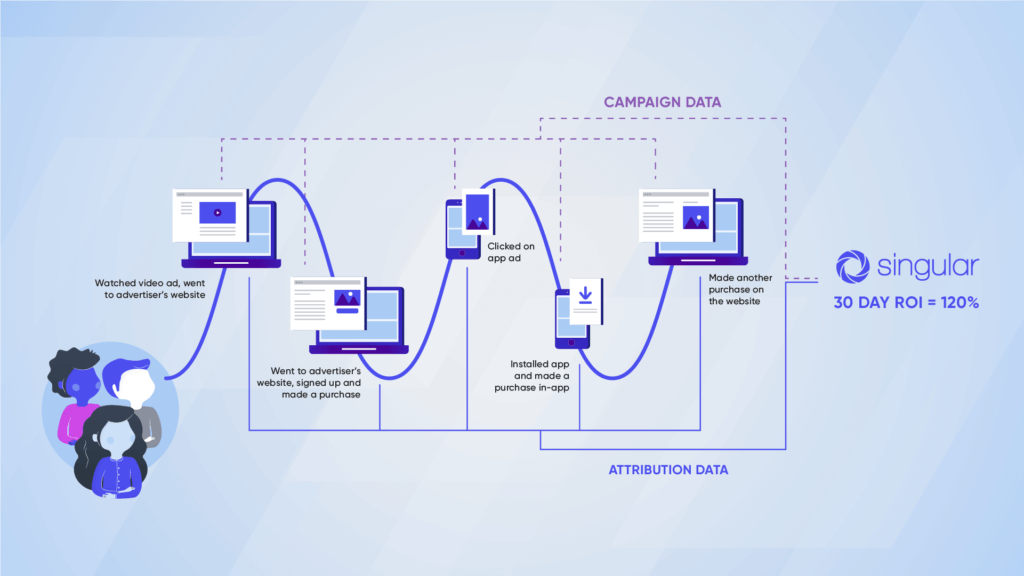How do you grow ROI while maintaining CPA and scale?
This is a question marketers face every day. And answering this question has become more complex as they advertise on more platforms across more devices than ever before. When conversions happen, it’s a struggle to connect the dots and understand what caused them.
Back when Singular was founded in 2014, we focused on solving this challenge first for the complex, highly fragmented, mobile ecosystem: providing a single solution that automatically collects and combines spend data and conversion data to expose mobile marketing performance, including ROI, at unrivaled levels of granularity.
That is powerful. And we quickly became the de facto solution for unifying campaign analytics and mobile attribution to expose ROI.
But in 2019, the game is different
Top brands advertise over a wide range of platforms to users on multiple devices. A customer may see an advertisement for a product on her desktop, and later buy that product on her mobile app. With today’s analytics, it’s hard to connect the two experiences and measure the customer journey accurately.
For mobile-first brands, this often leads to two separate teams, one web, one mobile app, using different tools, and even different metrics, to measure the customer journey. For web-first brands, it results in limited investment in mobile apps, preventing them from diversifying their marketing efforts to bring in incremental users, leaving untapped growth potential on the line.
Moreover, inaccurate measurement leads to misguided decision-making. Matter of fact, poor data quality costs brands an average of $15 million annually, according to Gartner. Making an investment and creative decisions with inaccurate and incomplete datasets is just plain costly.
In true Singular spirit, we sought to solve this new challenge for our customers so they can drive growth more effectively and efficiently in this multichannel world. And I’m happy to say that we have leveraged our vast experience in attribution and marketing analytics to do just that.
Cross-device, cross-platform attribution
Today, Singular is announcing the first-ever cross-platform and cross-device ROI analytics solution for growth marketers.
With the release of Cross-Device Attribution, Singular’s Marketing Intelligence Platform connects marketing spend data to conversion results across devices and platforms. First, we ingest granular spend and marketing data from thousands of sources. Then we connect it with attribution data from our easy-to-implement in-app and web SDKs as well as direct integrations with customer data platforms, analytics solutions, and internal BI systems, bringing the full customer journey into a single view. Finally, we match the two datasets.

The result is the most accurate cohort ROI and CPA metrics available to marketers, at the deepest levels of granularity including campaign, publisher and even creative.
That’s ground-breaking. It’s revolutionary.
But bringing cross-device and cross-platform ROI into Singular and measuring it accurately, at granular levels, is only the beginning to driving impactful growth.
Granular data for growth
Marketers can now access granular ROI cohort reporting that is more accurate than ever, as you can get clear, combined revenue for users across all devices. This is critical to achieving profitable growth and only possible with Singular – a complete platform that innovates beyond a single attribution solution.
Moreover, marketers can also utilize the wide set of capabilities that Singular’s Marketing Intelligence Platform offers to make smarter decisions and optimize their growth efforts with additional cross-device visibility; plus, they have more visibility into essential context such as the exact creative customers engaged with and the audience segments they belong to.
For example, you may find that a web channel’s impact is much higher than expected for specific types of customers. And now you can analyze the impact of the same creative across mobile and web.
In fact, we won’t be surprised if marketers start shifting investments with this new level of clarity. We are excited to see how growth strategists are going to rise above the crowd using this new solution to become part of the future wave of sophisticated marketers. Gone are the days of attribution feature wars – Marketing Intelligence has arrived.
Launching Cross-Device Attribution is just another step towards achieving our goal: to be every marketer’s indispensable tool in driving growth. We keep working not only to ensure that you can innovate your growth processes and have access to the highest data accuracy but also to ensure that we bring you the right insights at the right time to help you make timely strategic and operational decisions.
Are you ready to take part in the future of growth?